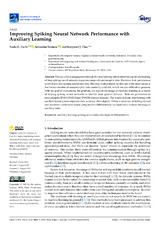Mostrar el registro sencillo del ítem
Improving spiking neural network performance with auxiliary learning
| dc.contributor.author | Cachi, Paolo G. | |
| dc.contributor.author | Ventura Soto, S. | |
| dc.contributor.author | Cios, Krzysztof | |
| dc.date.accessioned | 2023-09-12T10:38:30Z | |
| dc.date.available | 2023-09-12T10:38:30Z | |
| dc.date.issued | 2023 | |
| dc.identifier.issn | 2504-4990 | |
| dc.identifier.uri | http://hdl.handle.net/10396/25917 | |
| dc.description.abstract | The use of back propagation through the time learning rule enabled the supervised training of deep spiking neural networks to process temporal neuromorphic data. However, their performance is still below non-spiking neural networks. Previous work pointed out that one of the main causes is the limited number of neuromorphic data currently available, which are also difficult to generate. With the goal of overcoming this problem, we explore the usage of auxiliary learning as a means of helping spiking neural networks to identify more general features. Tests are performed on neuromorphic DVS-CIFAR10 and DVS128-Gesture datasets. The results indicate that training with auxiliary learning tasks improves their accuracy, albeit slightly. Different scenarios, including manual and automatic combination losses using implicit differentiation, are explored to analyze the usage of auxiliary tasks. | es_ES |
| dc.format.mimetype | application/pdf | es_ES |
| dc.language.iso | eng | es_ES |
| dc.publisher | MDPI | es_ES |
| dc.rights | https://creativecommons.org/licenses/by/4.0/ | es_ES |
| dc.source | Mach. Learn. Knowl. Extr., 5(3) (2023) | es_ES |
| dc.subject | Auxiliary learning | es_ES |
| dc.subject | Spiking neural networks; | es_ES |
| dc.subject | Implicit differentiation | es_ES |
| dc.title | Improving spiking neural network performance with auxiliary learning | es_ES |
| dc.type | info:eu-repo/semantics/article | es_ES |
| dc.relation.publisherversion | https://doi.org/10.3390/make5030052 | es_ES |
| dc.rights.accessRights | info:eu-repo/semantics/openAccess | es_ES |

